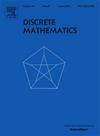The forb-flex method for odd coloring and proper conflict-free coloring of planar graphs
IF 0.7
3区 数学
Q2 MATHEMATICS
引用次数: 0
Abstract
We introduce a new technique useful for greedy coloring, which we call the forb-flex method, and apply it to odd coloring and proper conflict-free coloring of planar graphs. The odd chromatic number, denoted , is the smallest number of colors needed to properly color G such that every non-isolated vertex of G has a color appearing an odd number of times in its neighborhood. The proper conflict-free chromatic number, denoted , is the smallest number of colors needed to properly color G such that every non-isolated vertex of G has a color appearing uniquely in its neighborhood. Our new technique works by carefully counting the structures in the neighborhood of a vertex and determining if a neighbor of a vertex can be recolored at the end of a greedy coloring process to avoid conflicts. Combining this with the discharging method allows us to prove for planar graphs of girth at least 11, and for planar graphs of girth at least 10. These results improve upon the recent works of Cho, Choi, Kwon, and Park.
平面图形奇着色和适当无冲突着色的forb-flex方法
提出了一种贪心着色的新技术——forb-flex方法,并将其应用于平面图形的奇着色和适当无冲突着色。奇数色数,记作χo(G),是为G适当上色所需的最小颜色数,使得G的每个非孤立顶点的颜色在其邻域中出现奇数次。适当的无冲突色数,表示为χPCF(G),是为G适当上色所需的最小颜色数,使得G的每个非孤立顶点在其邻域中都具有唯一出现的颜色。我们的新技术的工作原理是仔细计算顶点附近的结构,并确定顶点的邻居是否可以在贪婪着色过程结束时重新着色,以避免冲突。将此方法与放电方法相结合,可以证明对于周长至少为11的平面图,χPCF(G)≤4,对于周长至少为10的平面图,χo(G)≤4。这些结果在Cho、Choi、Kwon和Park最近的研究成果的基础上得到了改进。
本文章由计算机程序翻译,如有差异,请以英文原文为准。
求助全文
约1分钟内获得全文
求助全文
来源期刊

Discrete Mathematics
数学-数学
CiteScore
1.50
自引率
12.50%
发文量
424
审稿时长
6 months
期刊介绍:
Discrete Mathematics provides a common forum for significant research in many areas of discrete mathematics and combinatorics. Among the fields covered by Discrete Mathematics are graph and hypergraph theory, enumeration, coding theory, block designs, the combinatorics of partially ordered sets, extremal set theory, matroid theory, algebraic combinatorics, discrete geometry, matrices, and discrete probability theory.
Items in the journal include research articles (Contributions or Notes, depending on length) and survey/expository articles (Perspectives). Efforts are made to process the submission of Notes (short articles) quickly. The Perspectives section features expository articles accessible to a broad audience that cast new light or present unifying points of view on well-known or insufficiently-known topics.
 求助内容:
求助内容: 应助结果提醒方式:
应助结果提醒方式:


